Chapter: Essentials of Anatomy and Physiology: Digestive System
Anatomy of Oral Cavity, Pharynx, and Esophagus
ORAL CAVITY, PHARYNX, AND ESOPHAGUS
Anatomy of the oral Cavity
The oral cavity (figure 16.4), or mouth, is the first part of the diges-tive tract. It is bounded by the lips and cheeks and contains the teethand tongue. The lips are muscular structures, formed mostly by theorbicularis oris (̄or-bik′̄u-l̄a′ris̄or′is) muscle (see figure 7.16). Theouter surfaces of the lips are covered by skin. The keratinized strati-fied epithelium of the skin becomes thin at the margin of the lips. The color from the underlying blood vessels can be seen through the thin, transparent epithelium, giving the lips a reddish-pink appearance. At the internal margin of the lips, the epithelium is continuous with the moist stratified squamous epithelium of the mucosa in the oral cavity.
The cheeks form the lateral walls of the oral cavity. The bucci-nator (bŭk′si-nā-tōr) muscles (see figure 7.16), located within thecheeks, flatten the cheeks against the teeth. The lips and cheeks are important in the process of mastication (mas-ti-kā ′ shŭ n), or
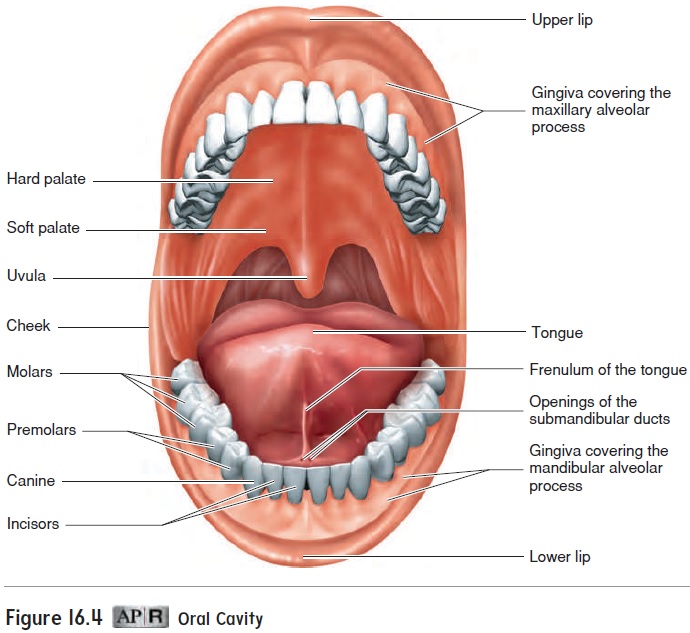
They help manipulate the food within the oral cavity and hold the food in place while the teeth crush or tear it. Mastication begins the process of mechanical digestion, which breaks down large food particles into smaller ones. The cheeks also help form words during the speech process.
The tongue is a large, muscular organ that occupies most of the oral cavity. The major attachment of the tongue is in the posterior part of the oral cavity. The anterior part of the tongue is relatively free, except for an anterior attachment to the floor of the mouth by a thin fold of tissue called the frenulum (fren′ ū-lŭm) (figure 16.4). The muscles associated with the tongue are described in chap-ter 7. The anterior two-thirds of the tongue is covered by papillae, some of which contain taste buds . The posterior one-third of the tongue is devoid of papillae and has only a few scattered taste buds. In addition, the posterior portion does contain a large amount of lymphatic tissue, which helps form the lingual tonsil .
The tongue moves food in the mouth and, in cooperation with the lips and cheeks, holds the food in place during mastication. It also plays a major role in the process of swallowing. In addition, the tongue is a major sensory organ for taste, as well as one of the major organs of speech.
Teeth
There are 32 teeth in the normal adult mouth, located in the mandible and maxillae. The teeth can be divided into quadrants:right upper, left upper, right lower, and left lower. In adults, each quadrant contains one central and one lateral incisor (in-sı̄′ zŏr; to cut); one canine (kā′ nı̄n; dog); first and second premolars (prē-mō′ lărz; molaris, a millstone); and first, second, and third molars (mō′ lărz). The third molars are called wisdom teeth because they usually appear in the late teens or early twenties, when the person is old enough to have acquired some degree of wisdom.
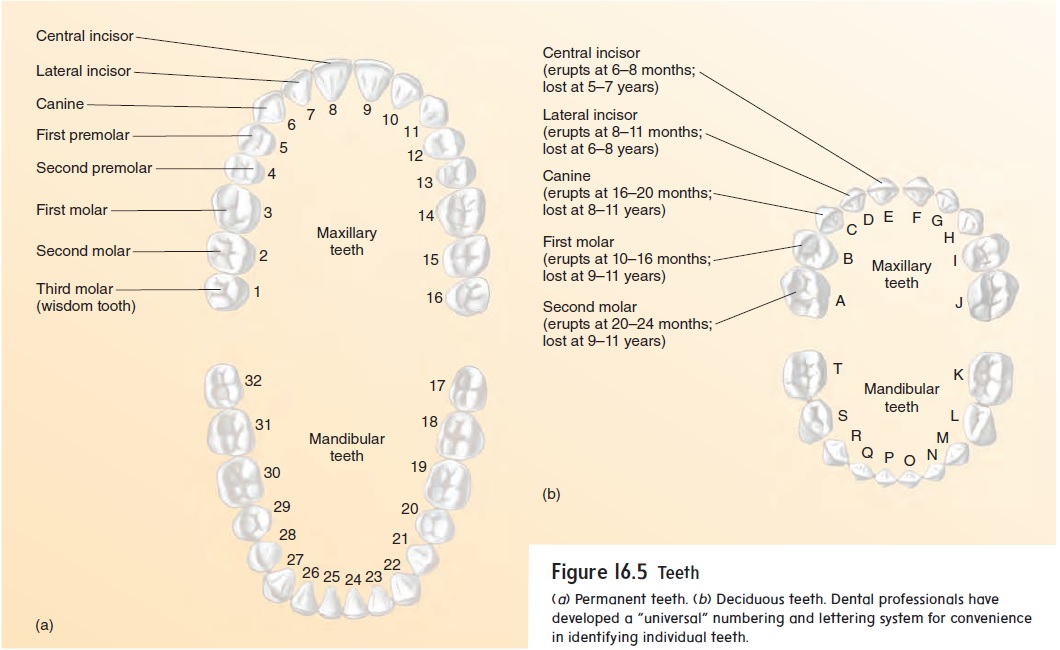
The teeth of adults are called permanent teeth, or second-ary teeth (figure 16.5a). Most of them are replacements for the20 primary teeth, or deciduous (dē-sid′ ū-ŭs) teeth, also called milk or baby teeth, which are lost during childhood (figure 16.5b).
Each tooth consists of a crown with one or more cusps (points), a neck, and a root (figure 16.6). The center of the tooth is a pulp cavity, which is filled with blood vessels, nerves, and connective tissue, called pulp. The pulp cavity is surrounded by a living, cellular, bonelike tissue called dentin (den′ tin; dens, tooth). The dentin of the tooth crown is covered by an extremely hard, acellular substance calledenamel, which protects the tooth against abrasion and acids produced by bacteria in the mouth. The surface of the dentin in the root is covered with cementum (se-men′ tŭm), which helps anchor the tooth in the jaw.

The teeth are rooted within alveoli (al-vē′ ō-lı̄; sockets) along the alveolar processes of the mandible and maxillae. The alveo-lar processes are covered by dense fibrous connective tissue and moist stratified squamous epithelium, referred to as the gingiva (jin′ ji-vă), or gums. The teeth are held in place by periodontal (per′ ē-ō-don′ tăl; around the teeth) ligaments, which are con-nective tissue fibers that extend from the alveolar walls and are embedded into the cementum.
Formation of dental caries (kār′ ēz), or tooth decay, is the result of the breakdown of enamel by acids produced by bacteria on the tooth surface. Enamel is nonliving and cannot repair itself. Consequently, a dental filling is necessary to prevent further dam-age. Periodontal disease is inflammation and degeneration of the periodontal ligaments, gingiva, and alveolar bone. This disease is the most common cause of tooth loss in adults.
Palate and Tonsils
The palate (pal′ ăt), or roof of the oral cavity, separates the oral cavity from the nasal cavity and prevents food from passing into the nasal cavity during chewing and swallowing. The palate consists of two parts. The anterior part contains bone and is called the hardpalate, whereas the posterior portion consists of skeletal muscle andconnective tissue and is called the soft palate (see figure 16.4). The uvula(ū′vū-lă; a grape) is a posterior extension of the soft palate.
The tonsils (ton′ silz) are located in the lateral posterior walls of the oral cavity, in the nasopharynx, and in the posterior surface of the tongue.
Salivary Glands
There are three major pairs of salivary (sal′ i-vār-ē) glands: the parotid, submandibular, and sublingual glands (figure 16.7). A con-siderable number of other salivary glands are scattered throughout the oral cavity, including on the tongue. Salivary glands produce saliva, which is a mixture of serous (watery) and mucous fluids. The salivary glands are compound alveolar glands. They have branching ducts with clusters of alveoli, resembling grapes, at the ends of the ducts .
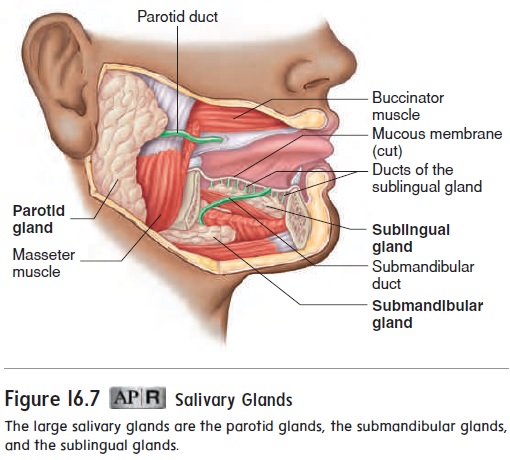
The largest of the salivary glands, the parotid (pă-rot′ id; beside the ear) glands, are serous glands located just anterior to each ear. Parotid ducts enter the oral cavity adjacent to the second upper molars.
Mumps (mŭmpz) is an inflammation of the parotid glandcaused by a viral infection. The inflamed parotid glands become swollen, often making the cheeks quite large. The virus causing mumps can also infect other structures. Mumps in an adult male may involve the testes and can result in sterility.
The submandibular (sŭb-man-dib′ ū-lăr; below the mandible) glands produce more serous than mucous secretions. Each glandcan be felt as a soft lump along the inferior border of the mandible. The submandibular ducts open into the oral cavity on each side of the frenulum of the tongue (see figure 16.4).
The sublingual (sŭb-ling′ gwăl; below the tongue) glands, the smallest of the three paired salivary glands, produce primarily mucous secretions. They lie immediately below the mucous mem-brane in the floor of the oral cavity. Each sublingual gland has 10–12 small ducts opening onto the floor of the oral cavity.
The sublingual (sŭb-ling′ gwăl; below the tongue) glands, the smallest of the three paired salivary glands, produce primarily mucous secretions. They lie immediately below the mucous mem-brane in the floor of the oral cavity. Each sublingual gland has 10–12 small ducts opening onto the floor of the oral cavity.
Saliva
Saliva (să-lı̄′ vă) helps keep the oral cavity moist and containsenzymes that begin the process of digestion. Saliva is secreted at the rate of approximately 1 liter (L) per day. The serous part of saliva, produced mainly by the parotid and submandibular glands, contains a digestive enzyme called salivary amylase (am′ il-ās) (table 16.1), which breaks the covalent bonds between glucose molecules in starch and other polysaccharides to produce the disaccharides maltose and isomaltose. Maltose and isomaltose have a sweet taste; thus, the digestion of polysaccharides by salivary amylase enhances the sweet taste of food.
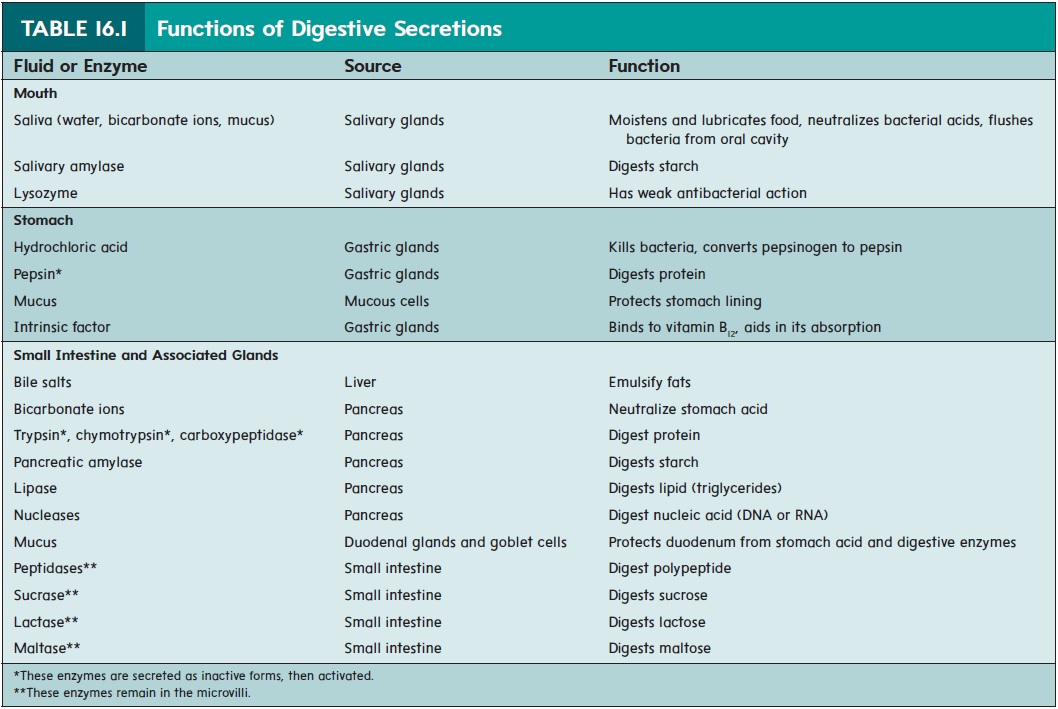
Food spends very little time in the mouth. Consequently, only about 5% of the total carbohydrates humans absorb are digested in the mouth. Also, most starches are contained in plant cells, which are surrounded by cell walls composed primarily of the polysaccharide cellulose (sel′ ū-lōs). Humans lack the necessary enzymes to digestcellulose. Cooking and thorough chewing of food disrupt the cel-lulose covering and increase the efficiency of the digestive process.
In addition to its role in digestion, saliva protects the mouth from bacterial infection by washing the oral cavity with lysozyme (lı̄′ sō-zı̄m), a mildly antibacterial enzyme. Saliva also neutralizes the pH in the mouth, which reduces the harmful effects of bacterial acids on tooth enamel. Lack of salivary gland secretion (which can result from radiation therapy) increases the chance of ulceration and infection of the oral mucosa and caries (cavities) formation in the teeth.
The serous part of saliva dissolves molecules, which must be in solution to stimulate taste receptors. The mucous secretions of the submandibular and sublingual glands contain a large amount of mucin (mū′sin), a proteoglycan that gives a lubricating quality to the secretions of the salivary glands.
Salivary gland secretion is regulated primarily by the auto-nomic nervous system, with parasympathetic stimulation being the most important. Salivary secretions increase in response to a variety of stimuli, such as tactile stimulation in the oral cav-ity and certain tastes, especially sour. Higher brain centers can stimulate parasympathetic activity and thus increase the activity of the salivary glands in response to the thought of food, to odors, or to the sensation of hunger. Sympathetic stimulation increases the mucous content of saliva. When a person becomes frightened and the sympathetic division of the autonomic nervous system is stimulated, the person may have a dry mouth with thick mucus.
Mastication
Food taken into the mouth is chewed, or masticated, by the teeth. The incisors and canines primarily cut and tear food, whereas the premolars and molars primarily crush and grind it. Mastication breaks large food particles into many small ones, which have a much larger total surface area than a few large particles would have. Because digestive enzymes act on molecules only at the surface of the food particles, mastication increases the efficiency of digestion.
Pharynx
The pharynx (far′ ingks), or throat, which connects the mouth with the esophagus, consists of three parts: the nasopharynx, the oro-pharynx, and the laryngopharynx . Normally, only the oropharynx and laryngopharynx transmit food. The posterior walls of the oropharynx and laryngopharynx are formed by the superior, middle, and inferior pharyngeal constrictor muscles.
Esophagus
The esophagus (̄e -sof′ ̆a -ğu s; gullet) is a muscular tube, lined with moist stratified squamous epithelium, that extends from the pharynx to the stomach. It is about 25 centimeters (cm) long and lies anterior to the vertebrae and posterior to the trachea within the mediastinum. The upper two-thirds of the esophagus has skeletal muscle in its wall, while the lower one-third has smooth muscle in its wall. It passes through the diaphragm and ends at the stomach. The esophagus transports food from the pharynx to the stomach. Upper and lower esophageal sphincters, located at the upper and lower ends of the esophagus, respectively, regulate the movement of food into and out of the esophagus. The lower esophageal sphincter is sometimes called the cardiac sphincter. Numerous mucous glands produce a thick, lubricating mucus that coats the inner surface of the esophagus.
Swallowing
Swallowing, ordeglutition(d̄e-gloo-tish′̆un), can be divided intothree phases: the voluntary phase, the pharyngeal phase, and the esophageal phase (figure 16.8). During the voluntary phase, a bolus, or mass of food, is formed in the mouth. The bolus is pushed by the tongue against the hard palate, forcing the bolus toward the posterior part of the mouth and into the oropharynx.

The pharyngeal phase of swallowing is a reflex that is initi-ated when a bolus of food stimulates receptors in the oropharynx. This phase of swallowing begins with the elevation of the soft palate, which closes the passage between the nasopharynx and oropharynx. The pharynx elevates to receive the bolus of food from the mouth. The three pharyngeal constrictor muscles then contract in succession, forcing the food through the pharynx. At the same time, the upper esophageal sphincter relaxes, and food is pushed into the esophagus. As food passes through the pharynx, the vestibular and vocal folds close, and theepiglottis (ep-i-glot′ is; upon the glottis, opening of the larynx) is tipped posteriorly, so that the opening into the larynx is covered. These movements prevent food from passing into the larynx.
The esophageal phase of swallowing is responsible for moving food from the pharynx to the stomach. Muscular con-tractions of the esophagus occur in peristaltic (per-i-stal′ tik; peri, around+ stalsis,constriction)waves(figure 16.9). A waveof relaxation of the esophageal muscles precedes the bolus of food down the esophagus, and a wave of strong contraction of the circular muscles follows and propels the bolus through the esophagus. Gravity assists the movement of material, espe-cially liquids, through the esophagus. However, the peristaltic contractions that move material through the esophagus are suf-ficiently forceful to allow a person to swallow even while doing a headstand or floating in the zero-gravity environment of space. The peristaltic contractions cause relaxation of the lower esopha-geal sphincter in the esophagus as the peristaltic waves approach the stomach.
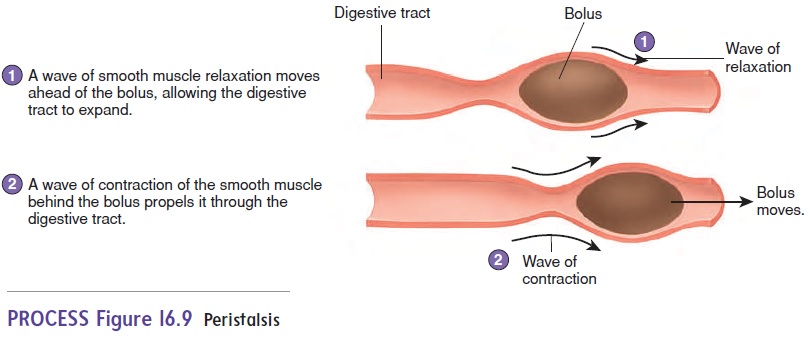
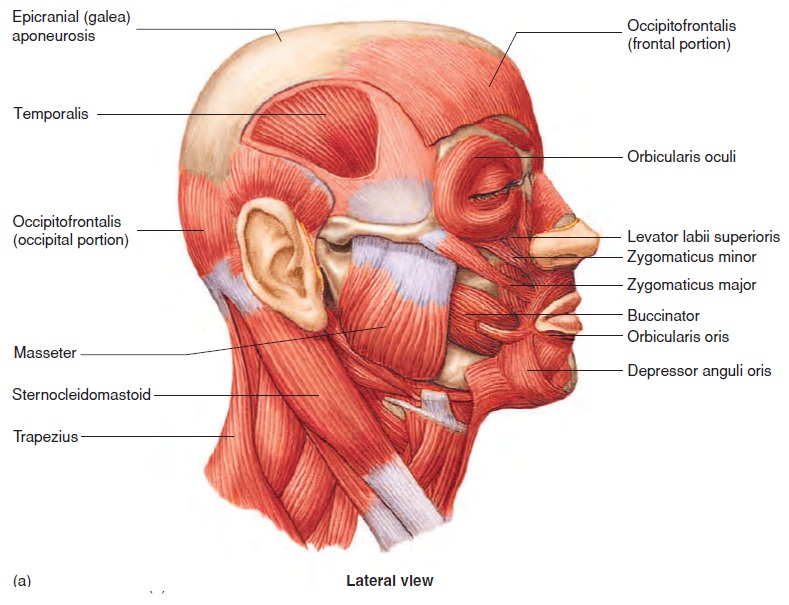
Related Topics